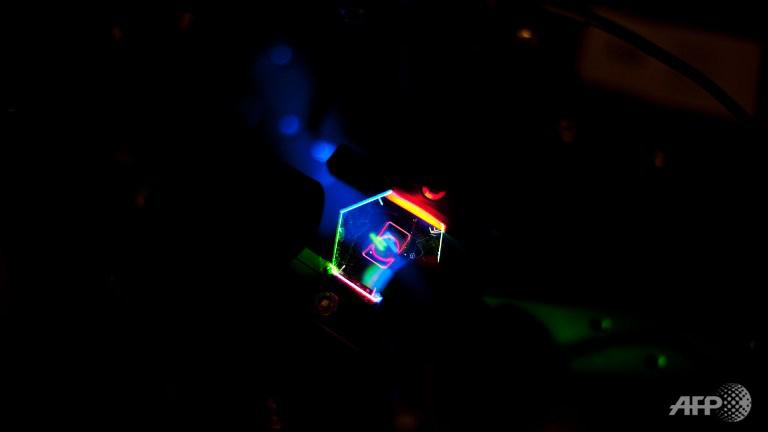
US researchers reported that they had made a display which gives a three-dimensional image that can be viewed without special glasses. (AFP/HEWLETT PACKARD LABORATORIES/KAR HAN)
PARIS: Fancy watching a movie on your mobile phone, where figures leap out from the screen in 3D, rather as Princess Leia did in that scene from “Star Wars”?
That’s the claim made by US researchers, who on Wednesday reported they had made a display which gives a three-dimensional image that can be viewed without special glasses and is intended for cellphones, tablets and watches.
Unlike the holographic projection used in George Lucas’ movie fantasy, their small prototype display is flat and backlit.
It uses a technology called diffractive optics to give 3D images that can be viewed from multiple angles, even if the device is tilted.
“Unlike a lot of technology out there that only does so-called horizontal parallax, which means that you only see 3D when you move your head left and right, we actually are talking about a technology that gives 3D for full parallax,” said David Fattal, who led a team at Hewlett-Packard Laboratories in Palo Alto, California.
“For example, if you were to display a 3D image of Planet Earth with the North Pole facing out from the screen, by turning your head around the display, you would actually be able to have a view of any country on the globe, you would be able to see all the way around,” Fattal told journalists in a telebriefing.
Diffractive optics meet a challenge posed by the human anatomy, according to the study, published on Wednesday by the journal Nature.
Humans view the world stereoscopically, meaning that our two eyes see two slightly different images because they are separated by about six centimetres (two and a half inches).
2D screening provides only a single flat image, which means the two eyes both see the same picture on the screen.
3D imaging, therefore, has to present a slightly different image to each eye.
Glasses-based systems work by having two lenses that each polarise the light in different directions, or by having cheap-and-cheerful — and headache-inducing — lenses of red and green. In the first case, the display has two simultaneous images, each with different polarisation; in the second, the two images have red and green outlines.
Current glasses-free systems, including some mobiles, use thin lenses called lenticules or parallax barriers that send an image towards each eye.
But the 3D effect is limited and can only be perceived if the viewer is positioned in a narrow zone so that the correct eye gets the correct image.
The best option would be Princess Leia-style holography. But right now, this cannot be used for images displayed at a normal video rate, as the demands in pixel density are just too great.
The new “autostereoscopic multiview display” uses a backlight whose surface has been etched with tiny refractors.
Each of these microscopic deflectors send individual points of light in specific directions. These individual pixels, put together, comprise the different images sent to each eyeball.
The demonstration models can send light in 14 distinct viewing directions, providing the 3D effect in an angle of 90 degrees at a distance of up to a metre (3.25 feet). Tests have been carried out with images or footage, at 30 frames per second, of flowers, a turtle or a corporate logo.
The scientists said the design can be ramped up to produce up to 64 directions, further widening the viewing zone.
Using glass of high refractive index, the field of view could be “close to 180 degrees,” they add.
“This current prototype is completely transparent and we think that even using a modulating device to achieve video rates, we can still retain most of the transparency,” said Fattal.
In commentary also carried by Nature, University of Cambridge computer specialist Neil Dodgson said major challenges lay ahead before the exploit would be commercially viable.
The new illumination system has much smaller pixels than mobile devices today, so more work has to be done to ensure that picture quality — which depends on pixel density — is not lost.
Another hurdle is to have the device manufactured “reliably, robustly and in quantity,” which may take years, said Dodgson, who also pointed to the expense of providing content filmed in 3D in order to provide the multiple images.
“The more nebulous question… (is) whether humans want or need 3D displays,” he noted. “Time will tell.” -AFP
